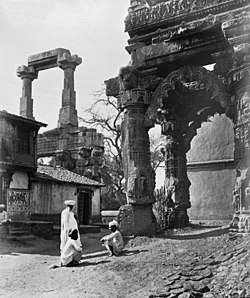| Rudra Mahalaya Temple | |||||||||||||||||
|---|---|---|---|---|---|---|---|---|---|---|---|---|---|---|---|---|---|
 Ruins of main portal, Toran, of Rudra Mahalaya, 1874 | |||||||||||||||||
| Alternative names | Rudra Mala | ||||||||||||||||
| General information | |||||||||||||||||
| Status | ruined | ||||||||||||||||
| Architectural style | Māru-Gurjara architecture | ||||||||||||||||
| Location | Siddhpur, Patan district, Gujarat | ||||||||||||||||
| Country | India | ||||||||||||||||
| Coordinates | 23°55′09″N72°22′45″E / 23.91917°N 72.37917°E | ||||||||||||||||
| Construction started | 943 CE | ||||||||||||||||
| Opened | 1140 CE | ||||||||||||||||
| Destroyed | 1296 CE and 1414 CE | ||||||||||||||||
| Technical details | |||||||||||||||||
| Material | sandstone | ||||||||||||||||
| Floor count | 2 | ||||||||||||||||
| Designations | ASI Monument of National Importance (N-GJ-164 for temple/163 for mosque) | ||||||||||||||||
| |||||||||||||||||
The Rudra Mahalaya Temple, also known as Rudramal, is a destroyed/desecrated Hindu temple complex at Siddhpur in the Patan district of Gujarat, India. Its construction was started in 943 CE by Mularaja and completed in 1140 CE by Jayasimha Siddharaja, a ruler of the Chaulukya dynasty. The Hindu temple was destroyed by the Sultan of Delhi, Alauddin Khalji, and later the Sultan of Gujarat, Ahmed Shah I (1410–1444) desecrated and substantially demolished the temple, and also converted part of it into the congregational mosque (Jami Masjid) of the city. Two torans (porches) and four pillars of the former central structure still stand along with the western part of the complex used as a congregational mosque.[ citation needed ]










